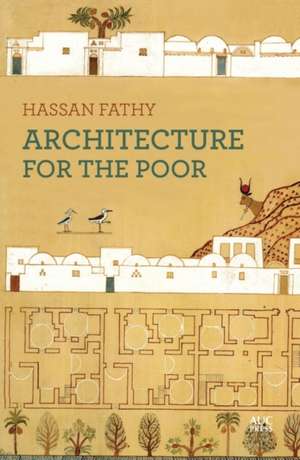Architecture for the Poor
Autor Hassan Fathyen Limba Engleză Paperback – 27 feb 2000
Architecture for the Poor describes Hassan Fathy's plan for building the village of New Gourna, near Luxor, Egypt, without the use of more modern and expensive materials such as steel and concrete. Using mud bricks, the native technique that Fathy learned in Nubia, and such traditional Egyptian architectural designs as enclosed courtyards and vaulted roofing, Fathy worked with the villagers to tailor his designs to their needs. He taught them how to work with the bricks, supervised the erection of the buildings, and encouraged the revival of such ancient crafts as claustra (lattice designs in the mudwork) to adorn the buildings.
Preț: 119.35 lei
Preț vechi: 136.76 lei
-13% Nou
Puncte Express: 179
Preț estimativ în valută:
22.84€ • 24.82$ • 19.20£
22.84€ • 24.82$ • 19.20£
Carte indisponibilă temporar
Doresc să fiu notificat când acest titlu va fi disponibil:
Se trimite...
Preluare comenzi: 021 569.72.76
Specificații
ISBN-13: 9789774245756
ISBN-10: 977424575X
Pagini: 368
Ilustrații: 132 black and white illustrations
Dimensiuni: 150 x 230 x 23 mm
Greutate: 0.59 kg
Editura: The American University in Cairo Press (UK)
Colecția The American University in Cairo Press
Locul publicării:United Kingdom
ISBN-10: 977424575X
Pagini: 368
Ilustrații: 132 black and white illustrations
Dimensiuni: 150 x 230 x 23 mm
Greutate: 0.59 kg
Editura: The American University in Cairo Press (UK)
Colecția The American University in Cairo Press
Locul publicării:United Kingdom
Notă biografică
Hassan
Fathy
(1900-89)
taught
at
the
Faculty
of
Fine
Arts
of
Cairo
University
and
served
as
head
of
its
Department
of
Architecture.
He
received
the
Aga
Khan
Award
for
Architecture
in
1980,
and
the
Union
of
International
Architects
Gold
Medal
in
1984.
He
was
also
the
founder
and
director
of
the
International
Institute
for
Appropriate
Technology.
Cuprins
Foreword by William R. Polk
Preface
1. PRELUDE: DREAM AND REALITY
Paradise Lost: The Countryside
Mud Brick: Sole Hope for Rural Reconstruction
Mud for Roofing, Bahtim: Trial and Error
Nubia: Survival of an Ancient Technique of Vaulting
The Nubian Masons at Work: First Successes
Ezbet el Basry: Iblis in Ambush
A Tomb Robbery Begets a Pilot Housing Project
Birth of New Gourna: The Site
2. CHORALE: MAN, SOCIETY, AND TECHNOLOGY
Architectural Character
The Process of Decision Making
Tradition's Role
Saving Individuality in the Village
Traditional Village Crafts Restored
The Use of Mud Brick an Economic Necessity
Reestablishment of the "Trinity": Owner, Architect, and Craftsman
Vernacular Architecture of Old Gourna
Change with Constancy
Climate and Architecture
Orientation of Houses Determined Partly by Sun, Partly by Wind
The Malkaf, or Wind Catch
Society and Architecture
Kinship Structure and Local Custom
Socioeconomic Considerations
Rural Crafts in Gourna
The Plan of New Gourna
Public Service Buildings and Amenities
The Peasant House
Combating Bilharzia
Gourna, A Pilot Project
The Cooperative System
In-Service Training
Gourna Not an End in Itself
A Stillborn Experiment, Mit-el-Nasara
National Program for Rural Reconstruction
3. FUGUE: ARCHITECT, PEASANT, AND BUREAUCRAT
First Season: 1945-46
Second Season: 1946-47
Third Season: 1947-48
4. FINALE: GOURNA DORMANT
An Architect in Search of a Patron
Slander Continues
Gourna Revisited
Gourna in Nabaroh
Appendix I: Cost Analysis of Labor and Rates of the Execution of Works
Cost Analysis of Materials and Labor Used in Gourna Village
Cost of Stone
Sand
Construction
Appendix II: In-Service Training
Appendix III: Organization of Work
Appendix IV: Foundations
Appendix V: Brick Making
Extract from Colonel Debes's Experiments
Extract from Dr. Mustapha Yehya's Experiments
Appendix VI: Cost Analysis at the Moment when the Project Was Handed Over to the Ministry of Social Affairs
Glossary
Illustrations
Preface
1. PRELUDE: DREAM AND REALITY
Paradise Lost: The Countryside
Mud Brick: Sole Hope for Rural Reconstruction
Mud for Roofing, Bahtim: Trial and Error
Nubia: Survival of an Ancient Technique of Vaulting
The Nubian Masons at Work: First Successes
Ezbet el Basry: Iblis in Ambush
A Tomb Robbery Begets a Pilot Housing Project
Birth of New Gourna: The Site
2. CHORALE: MAN, SOCIETY, AND TECHNOLOGY
Architectural Character
The Process of Decision Making
Tradition's Role
Saving Individuality in the Village
Traditional Village Crafts Restored
The Use of Mud Brick an Economic Necessity
Reestablishment of the "Trinity": Owner, Architect, and Craftsman
Vernacular Architecture of Old Gourna
Change with Constancy
Climate and Architecture
Orientation of Houses Determined Partly by Sun, Partly by Wind
The Malkaf, or Wind Catch
Society and Architecture
Kinship Structure and Local Custom
Socioeconomic Considerations
Rural Crafts in Gourna
The Plan of New Gourna
Public Service Buildings and Amenities
The Peasant House
Combating Bilharzia
Gourna, A Pilot Project
The Cooperative System
In-Service Training
Gourna Not an End in Itself
A Stillborn Experiment, Mit-el-Nasara
National Program for Rural Reconstruction
3. FUGUE: ARCHITECT, PEASANT, AND BUREAUCRAT
First Season: 1945-46
Second Season: 1946-47
Third Season: 1947-48
4. FINALE: GOURNA DORMANT
An Architect in Search of a Patron
Slander Continues
Gourna Revisited
Gourna in Nabaroh
Appendix I: Cost Analysis of Labor and Rates of the Execution of Works
Cost Analysis of Materials and Labor Used in Gourna Village
Cost of Stone
Sand
Construction
Appendix II: In-Service Training
Appendix III: Organization of Work
Appendix IV: Foundations
Appendix V: Brick Making
Extract from Colonel Debes's Experiments
Extract from Dr. Mustapha Yehya's Experiments
Appendix VI: Cost Analysis at the Moment when the Project Was Handed Over to the Ministry of Social Affairs
Glossary
Illustrations














